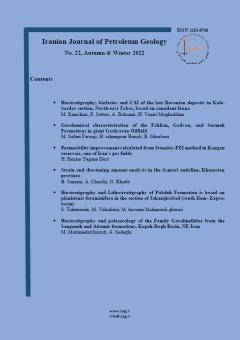سرشت نمایی سنگ منشاء سازندهای سورمه، فهلیان، و گدوان در میدان عظیم نفتی گچساران
الموضوعات : Geochemistryمجید صفائی فاروجی 1 , حسین رحیم پور بناب 2 , بیوک قربانی 3
1 - دانشگاه تهران
2 - دانشگاه تهران
3 - پژوهشگاه صنعت نفت
الکلمات المفتاحية: سنگ منشاءسورمه فهلیانگدوان پتانسیل هیدروکربورزایی,
ملخص المقالة :
هدف پژوهش پیش رو ارزیابی ژئوشیمیایی آلی سازندهای فهلیان، گدوان، و سورمه به عنوان سنگ های منشاء احتمالی در میدان نفتی گچساران با استفاده از روش پیرولیز راک اِوَل می باشد. تمام نمونه های هر سه سازند دارای مقادیر شاخص مهاجرت (S1/TOC) کمتر از 5/1 می باشند که نشاندهنده طبیعت برجای هیدروکربورهای موجود در آنها می باشد. نمودارهای TOC در مقابل S2 و TOC در مقابل S1+S2 حاکی از پتانسیل هیدروکربورزایی مناسب برای سازندهای فهلیان و سورمه و مناسب تا خوب برای سازند گدوان است. کروژن موجود در سازندهای فهلیان و سورمه از نوع III و سازند گدوان از نوع مخلوط II-III و نوع II، تعیین شد. از اینرو، سازندهای فهلیان و سورمه حاوی مواد آلی با منشاء خشکی (گاززا)، و سازند گدوان حاوی مواد آلی با هر دو منشاء آواری و دریایی (با توانایی تولید هر دوی نفت و گاز) می باشند. مطابق با نمودار T max در مقابل شاخص هیدروژن (HI)، سازند گورپی سازندی با توانایی تولید مخلوط نفت و گاز، و گاز می باشد و سازندهای فهلیان و سورمه سازندهایی با توانایی تولید فقط گاز می باشند. اما بر اساس ترسیم مقادیر TOC در برابر S2/S3، هر سه سازند گدوان، فهلیان، و سورمه سازندهایی گاززا تعیین شدند. از لحاظ نوع رخساره آلی، سازند سورمه در بخش CD، سازند فهلیان در بخش C و CD، و سازند گدوان عمدتاً در بخش BC و C از نمودار جونز قرار می گیرند. از اینرو، سازند گدوان نسبت به سازند فهلیان و این سازند نسبت به سازند سورمه در شرایط احیایی تر نهشته شده اند. همچنین، هر سه سازند گدوان، فهلیان، و سورمه از لحاظ بلوغ حرارتی در پنجره نفت زایی قرار می گیرند، با این تفاوت که بلوغ سازند سورمه از فهلیان و سازند فهلیان از گدوان بیشتر است.
مقاله: زینل زاده ا.، معین پور م.، شایسته م.، حیدری فرد م.، 1389، مدل سازی دوبعدی سیستم هیدروکربوری میادین گچساران و بی بی حکیمه، مجله پژوهش های چینه نگاری و رسوب شناسی، سال بیست و ششم، شماره پیاپی 41، شماره چهارم، صفحات 111 تا 124.
Alavi, M., 2004. Regional stratigraphy of the Zagros fold-thrust belt of Iran and its proforeland evolution. Am. J. Sci. 304(1), 1–20.
Tissot and Welte., 1978. . Petroleum Formation and Occurrence: A New Approach to Oil and Gas Exploration., Springer-Verlag.
Dembicki, H., 2016. Practical petroleum geochemistry for exploration and production. Elsevier
Dembicki Jr, H., 2009. Three common source rock evaluation errors made by geologists during prospect or play appraisals. Am. Assoc. Pet. Geol. Bull. 93, 341–356.
Espitalié, J., Laporte, J.L., Madec, M., Marquis, F., Leplat, P., Paulet, J., 1977. Méthode rapide de caractérisation des roches mères, de leur potential pétrolier et de leu degree d’évolution. Rev. l’Institut Français du Pétrole 32, 23–45.
Hakimi, M.H., Abdullah, W.H., Alqudah, M., Makeen, Y.M., Mustapha, K.A., 2016. Organic geochemical and petrographic characteristics of the oil shales in the Lajjun area, Central Jordan: Origin of organic matter input and preservation conditions. Fuel 181, 34–45.
Hunt, J.M., 1996. Petroleum geochemistry and geology. WH Freeman New York.
James, G.A., Wynd, J.G., 1965. Stratigraphic nomenclature of Iranian oil consortium agreement area. Am. Assoc. Pet. Geol. Bull. 49, 2182–2245.
Jones, R.., 1987. Organic Facies. In: Brooks, J., Welte, D. (Eds.), Advances in Petroleum Geochemistry. Acad. Press. New York 1–90.
Katz, B.J., Elrod, L.., 1983. Organic geochemistry of offshore California, Middle Miocene to Lower Pliocene strata. Geochim. Cosmochim. Acta 47, 389–396.
Maravelis, A.G., Chamilaki, E., Pasadakis, N., Zelilidis, A., Collins, W.J., 2017. Hydrocarbon generation potential of a Lower Permian sedimentary succession (Mount Agony Formation): Southern Sydney Basin, New South Wales, Southeast Australia. Int. J. Coal Geol. 183, 52–64.
Motiei, H., 1993. Stratigraphy of Zagros. Treatise Geol. Iran 60, 151.
Nairn, A.E.M., Alsharhan, A.., 1997. Sedimentary basins and petroleum geology of the Middle East, Elsevier.
Ola, P.S., Aidi, A.K., Bankole, O.., 2018. Clay mineral diagenesis and source rock assessment in the Bornu Basin, Nigeria: Implications for thermal maturity and source rock potential. Mar. Pet. Geol. 89, 653–664.
Peters, K.E., 1986. Guidelines for evaluating petroleum source rock using programmed pyrolysis. Am. Assoc. Pet. Geol. Bull. 70, 318–329.
Peters, K.E., Cassa, M.R., 1994. Applied source rock geochemistry: Chapter 5: Part II. Essential elements.
Peters, K.E., Moldowan, J.M., 1993. The biomarker guide: interpreting molecular fossils in petroleum and ancient sediments.
Setudehnia, A., 1978. The mesozoic sequence in southwest Iran and adjacent areas. J. Pet. Geol. 1, 3–42.
Sharland, P.R., 2001. Arabian Plate sequence stratigraphy, Gulf PetroLink, Manama, Bahrain.
Tissot, B., Durand, B., Espitalie, J., Combaz, A., 1974. Influence of the nature and diagenesis of organic matter in the formation of petroleum. Am. Assoc. Pet. Geol. Bull. 58, 499–506.
Tissot, B.P., Welte, D.H., 1984. Petroleum Formation and Occurrence, springer.
Van Buchem, F.S.P., Allan, T., Lausen, G.V., Lotfpour, M., Moallemi, A., Monibi, S., Motiei, H., Pickard, N., Tahmasbi, A.R.,
Vedrenne, V., Vincent, B., 2010. . Regional stratigraphic architecture and reservoir types of the Oligo-Miocene deposits in the Dezful Embayment (Asmari and Pabdeh Formations) SW Iran. GEOL. SOC. SPEC. PUBL, London 329, 219–263.
Yandoka, B.M.S., Abdullah, W.H., Abubakar, M.B., Hakimi, M.H., Jauro, A., Adegoke, A.K., 2016. Organic geochemical characterisation of shallow marine Cretaceous formations from Yola Sub-basin, Northern Benue Trough, NE Nigeria. J. African Earth Sci. 117, 235–251.
Ziegler, M.A., 2001, 2001. Late Permian to Holocene paleofacies evolution of the Arabian Plate and its hydrocarbon occurrences. GeoArabia 6 (3), 445–504.


